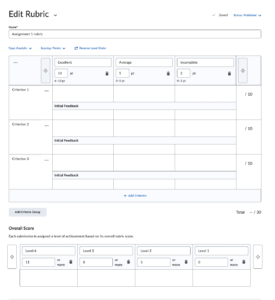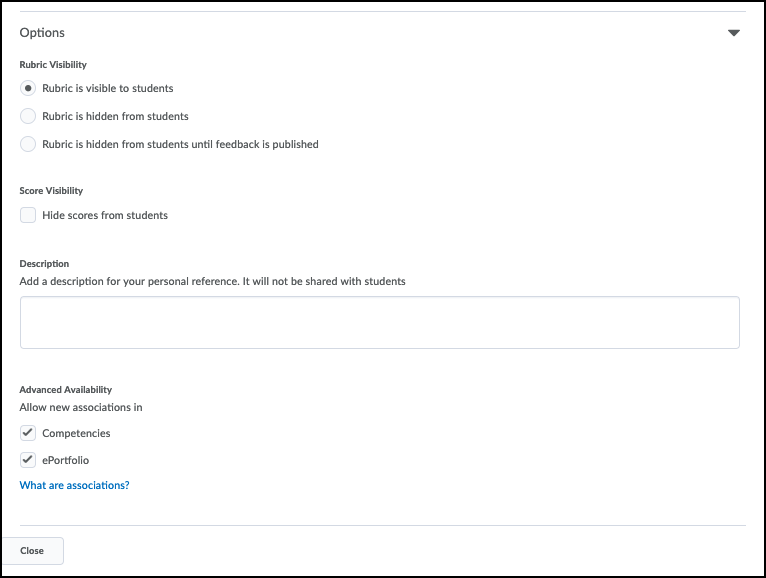Accessing the Rubrics Tool:
- Click Assessment on the Course Navbar.
- From the drop-down menu select Rubrics.
Creating a New Rubric:
- On the rubrics page select New Rubric
- Under Status, you are able to choose between the following Published, Archived or Draft.
- Enter a Name for the rubric in the Name field.
- From the Type drop-down select Analytic.
- From the Scoring drop-down choose either No Score, Points, or Custom Points.
- No Score: Text only assesses criteria based text levels such as Exceeds Expectations, Meets Expectations, etc.
- Points: Similar to no score only but allows you to assign a point value to each level such as Exceeds Expectations (100), Meets Expectations (75).
- Custom Points: Similar to points but allows you to assign different point values for each level based on each individual criteria. For example, in the Speaking Criteria, the Exceeds Expectation level is 100 points. In the Listening Criteria, the Exceeds Expectations level is 60 points.
- Rubric level ranges below the points are visible while creating and evaluating rubrics, except for holistic rubrics and non-sequential custom points. Rubric level ranges are also visible to students.

Note: We recommend using Custom Points so that you can change the points for each criterion and level if required. If you choose points the values are automatically assigned based on the number of levels and criterion created.
Options:
Rubric Visibility
You can choose between the following three options:
- Rubric is Visible to students
- Rubric is Hidden from students
- Rubric is Hidden from students until feedback is published
Score Visibility
- Hide Scores from students
Add Description if applicable
Advanced Availablity
To associate a rubric with other tools you must check the appropriate box under ‘Allow New Associations in’.
- To allow association with grade items, assignments, quizzes and discussion topics check the box beside Competencies.
- To allow association with ePortfolio select ePortfolio.
Note: Once a rubric is associated with another tool it can no longer be edited or deleted.
Click Save
Best Practices
- Since rubric work is auto-saved, there is no need to continuously Save the rubric. Instead, use the Publish and Save Draft options to make feedback visible immediately or later.
- Leave overall activity feedback in Overall Feedback for the activity, and not in the rubric. It will display to the learner in a nice consistent block, followed by a completed rubric with detailed criteria feedback.
- Reserve the use of rubric criteria feedback for assessor additional comments (in plain text). Criteria feedback will not be copied to Overall Feedback for the activity.
- Be assured that your learners will see your rubric and overall activity feedback in a consistent presentation across User Progress, Content, Assignments, Discussions and Grades
- Treat rubric Total as the numeric score that is transferred and communicated in Grades. Use Level Achieved as additional information of overall achievement. Note that it will be possible to exclude the Level Achieved section in the future.
- Be assured that the Scoring Rubric automatically contributes to the activity Score.
- In the case of multiple rubrics, choose whether you want to assess an individual rubric or all rubrics in the same dialog in Assignments
- Choose the rubric visibility setting to control whether the rubric is intended for communication of feedback to the learner or for other assessment purposes.
